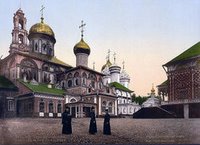Samara: Home to Stalin's Bunker
Samara, known as Kuybyshev during Soviet times, is a 1+ million cityon the Volga about 600 miles southeast of Russia. And yes, Stalin's bunker was situated in Samara- indeed, the city was the country's secondary capital from 1941-43. Because the city was involved in aerospace manufacturing (including space flight), it was a 'closed city' during the cold war. (more on the bunker).
The twin city of St. Louis seems fitting. The site reveals,
Russia's get-ahead Volga region of Samara is seeking to secure itself a
glittering future as a center for Western capital, by setting up its own gold
reserves to underpin foreign investment. Samara's liberal governor Konstantin
Titov says the ambitious food-for-gold plan could help secure the region, sited
1,000 kilometers (some 620 miles) from Moscow, its place as a favored home for
overseas funds.
A worthwhile site, The Jews of Samara, notes that
The city of Samara was founded in 1568 in order to defend the southeastern
borders of the Russian state from Nogay and Crimean Tatars...(and)
Samara served as shelter for the participants in the peasant revolts of
Stepan Razin (c.1630-1671) and Yemelyan Pugachev (c.1742-1775).
Until they were relocated in 1941, many German Catholics had settled in the Samara region (among elsewhere on the Volga as well).
Strangely enough, Bulgarians produced the Samara region's flag
On the negative side, TB and hepatitis B/D appear to be problems as well as contract-style killings in the automobile industry. And the city appears not to be growing in population anymore.
photos and more photos of the city

